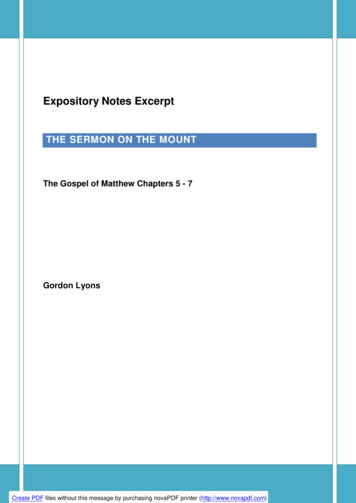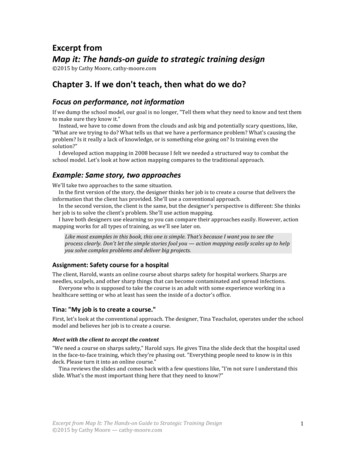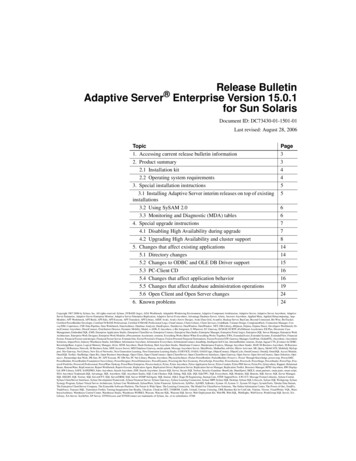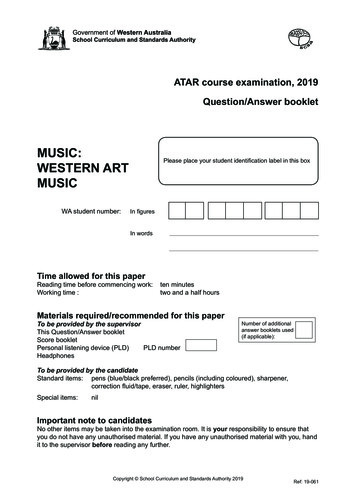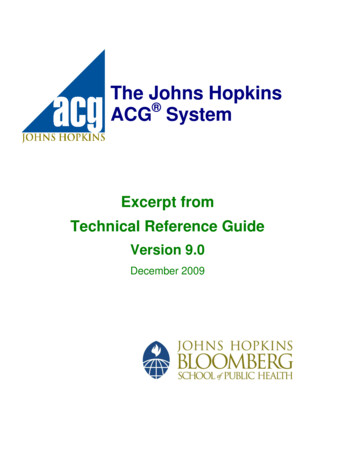
Transcription
The Johns Hopkins ACG SystemExcerpt fromTechnical Reference GuideVersion 9.0December 2009
Adjusted Clinical Groups (ACGs)3-iImportant Warranty Limitation and Copyright NoticesCopyright 2009, The Johns Hopkins University. All rights reserved.This document is produced by the Health Services Research & Development Center atThe Johns Hopkins University, Bloomberg School of Public Health.The terms The Johns Hopkins ACG System, ACG System, ACG , ADG , AdjustedClinical Groups , Ambulatory Care Groups , Aggregated Diagnostic Groups ,Ambulatory Diagnostic Groups , Johns Hopkins Expanded Diagnosis Clusters ,EDCs , ACG Predictive Model , Rx-Defined Morbidity Groups , Rx-MGs , ACG RxGaps , ACG Coordination Markers , ACG-PM , Dx-PM , Rx-PM and DxRx-PM are trademarks of The Johns Hopkins University. All materials in this document arecopyrighted by The Johns Hopkins University. It is an infringement of copyright law todevelop any derivative product based on the grouping algorithm or other informationpresented in this document.This document is provided as an information resource on measuring population morbidityfor those with expertise in risk-adjustment models. The documentation should be used forinformational purposes only. Information contained herein does not constituterecommendation for or advice about medical treatment or business practices.Copies may be made only by the individual who requested the documentation initiallyfrom Johns Hopkins or their agents and only for that person's use and those of his/hercoworkers at the same place of employment. All such copies must include the copyrightnotice above, this grant of permission and the disclaimer below must appear in all copiesmade; and so long as the name of The Johns Hopkins University is not used in anyadvertising or publicity pertaining to the use or distribution of this software withoutspecific, written prior authorization.Disclaimer: This documentation is provided AS IS, without representation as to its fitnessfor any purpose, and without warranty of any kind, either express or implied, includingwithout limitation the implied warranties of merchantability and fitness for a particularpurpose. The Johns Hopkins University and the Johns Hopkins Health System shall notbe liable for any damages, including special, indirect, incidental, or consequentialdamages, with respect to any claim arising out of or in connection with the use of thedocumentation, even if it has been or is hereafter advised of the possibility of suchdamages. The Johns Hopkins ACG System, Version 9.0Technical Reference Guide
3-iiAdjusted Clinical Groups (ACGs)3 Adjusted Clinical Groups (ACGs)A Brief Overview . 3-4The Development of the ACGs . 3-4How ACGs Work . 3-5Overview of the ACG Assignment Process . 3-6Step 1: Mapping ICD Codes to a Parsimonious Set of AggregatedDiagnosis Groups (ADGs) . 3-6Table 1: ADGs and Common ICD-9-CM Codes Assigned to Them . 3-7Table 2: Major ADGs for Adult and Pediatric Populations . 3-9Step 2: Creating a Manageable Number of ADG Subgroups(CADGs) . 3-9Table 3: The Collapsed ADG Clusters and the ADGs That TheyComprise . 3-10Step 3: Frequently Occurring Combinations of CADGs (MACs) . 3-11Table 4: MACs and the Collapsed ADGs Assigned to Them . 3-11Step 4: Forming the Terminal Groups (ACGs) . 3-12Table 5: The Final ACG Categories . 3-14Figure 1: ACG Decision Tree . 3-22Figure 2: Decision Tree for MAC-12—Pregnant Women . 3-24Figure 3: Decision Tree for MAC-26—Infants. 3-26Figure 4: Decision Tree for MAC-24—Multiple ADG Categories . 3-28Clinical Aspects of ACGs . 3-29Duration . 3-29Severity. 3-30Diagnostic Certainty . 3-30Etiology . 3-30Expected Need for Specialty Care . 3-30Table 6: Duration, Severity, Etiology, and Certainty of theAggregated Diagnosis Groups (ADGs) . 3-31Clinically Oriented Examples of ACGs. 3-33Chronic Illnesses . 3-33Example 1: Hypertension . 3-34Example 2: Diabetes Mellitus . 3-35Pregnancy . 3-37Example 3: Pregnancy/Delivery with Complications . 3-37Technical Reference Guide The Johns Hopkins ACG System, Version 9.0
Adjusted Clinical Groups (ACGs)3-iiiTable 7: Clinical Classification of Pregnancy/Delivery ACGs . 3-38Infants . 3-38Example 4: Infants . 3-39Table 8: Clinical Classification of Infant ACGs . 3-40 The Johns Hopkins ACG System, Version 9.0Technical Reference Guide
Adjusted Clinical Groups3-4A Brief OverviewThe Johns Hopkins ACG Case-Mix System (―the ACG System‖) is a statistically valid,diagnosis-based, case-mix methodology that allows healthcare providers, health plans, andpublic-sector agencies to describe or predict a population‘s past or future healthcare utilizationand costs. The ACG System is also widely used by researchers and analysts to compare variouspatient populations‘ prior health resource use, while taking into account morbidity or illnessburden.Adjusted Clinical Group actuarial cells, or ACGs, are the building blocks of the Johns HopkinsACG Case-Mix System (―the ACG System‖) methodology. ACGs are a series of mutuallyexclusive, health status categories defined by morbidity, age, and sex. They are based on thepremise that the level of resources necessary for delivering appropriate healthcare to a populationis correlated with the illness burden of that population.ACGs are used to determine the morbidity profile of patient populations to more fairly assessprovider performance, to reimburse providers based on the health needs of their patients, and toallow for more equitable comparisons of utilization or outcomes across two or more patient orenrollee aggregations.The Development of the ACGsThe concept of ACG actuarial cells grew out of research by Dr. Barbara Starfield and hercolleagues in the late 1970s when they examined the relationship between morbidity or illnessburden and healthcare services utilization among children in managed care settings. The researchteam theorized that the children using the most healthcare resources were not those with a singlechronic illness, but rather were those with multiple, seemingly unrelated conditions. To test theiroriginal hypothesis, illnesses found within pediatric HMO populations were grouped into fivediscrete categories:1. Minor illnesses that are self-limited if treated appropriately, e.g., the flu, or chicken pox.2. Illnesses that are more severe but also time-limited if treated appropriately, e.g., a broken legor pneumonia.3. Medical illnesses that are generally chronic and which remain incurable even with medicaltherapy, e.g., diabetes or cystic fibrosis.4. Illnesses resulting from structural problems that are generally not curable even with adequateand appropriate intervention, e.g., cerebral palsy or scoliosis.5. Psychosocial conditions, e.g., behavior problems or depression.The Johns Hopkins team‘s findings supported the hypothesis that clustering of morbidity is abetter predictor of health services resource use than the presence of specific diseases. ThisTechnical Reference GuideThe Johns Hopkins ACG System, Version 9.0
Adjusted Clinical Groups (ACGs)3-5finding forms the basis of the current ACG System and remains the fundamental concept thatdifferentiates ACGs from other case-mix adjustment methodologies.Since this early research more than two decades ago, the Johns Hopkins ACG Case-Mix Systemhas been refined and expanded based on years of extensive research and development incollaboration with over 25 private and public health plans. The peer reviewed research literatureon the ACG System by the Johns Hopkins team and others is quite extensive and we encourageyou to study it. (See Bibliography at the end of this guide for a complete listing of ACG-relatedpublications.)How ACGs WorkACGs are a person-focused method of categorizing patients‘ illnesses. Over time, each persondevelops numerous conditions. Based on the pattern of these morbidities, the ACG approachassigns each individual to a single ACG category. Thus, an ACG captures the specific clusteringof morbidities experienced by a person over a given period of time, such as a year.The ACG System assigns all ICD (-9,-9-CM,-10) codes to one of 32 diagnosis clusters known asAggregated Diagnosis Groups, or ADGs. Individual diseases or conditions are placed into asingle ADG cluster based on five clinical dimensions:Duration of the condition (acute, recurrent, or chronic): How long will healthcare resourcesbe required for the management of this condition?Severity of the condition (e.g., minor and stable versus major and unstable): How intenselymust healthcare resources be applied to manage the condition?Diagnostic certainty (symptoms versus documented disease): Will a diagnostic evaluationbe needed or will services for treatment be the primary focus?Etiology of the condition (infectious, injury, or other): What types of healthcare serviceswill likely be used?Specialty care involvement (e.g., medical, surgical, obstetric, hematology): To what degreewill specialty care services be required?All diseases--even those yet to be discovered--can be classified along these dimensions andcategorized into one of these 32 ADG clusters1.Because most management applications for population-based case-mix adjustment systemsrequire that patients be grouped into single, mutually exclusive categories, the ACGmethodology uses a branching algorithm to place people into one of 932 discrete categories based1Please note that originally when the ACG System was termed the Ambulatory Care Group System, ADG stood forAmbulatory Diagnostic Groups. Today, we retain the ADG acronym and call them Aggregated Diagnosis Groups.2There are 82 default categories and 93 if all optional branchings are turned on.The Johns Hopkins ACG System, Version 9.0Technical Reference Guide
Adjusted Clinical Groups3-6on their assigned ADGs, their age and their sex. The result is that individuals within a givenACG have experienced a similar pattern of morbidity and resource consumption over the courseof a given year.ACGs can be assigned to individuals using readily available diagnostic information derived fromoutpatient or ambulatory physician visit claims records, encounter records, inpatient hospitalclaims, and computerized discharge abstracts. A patient/enrollee is assigned to a single ACGbased on the diagnoses assigned by all clinicians seeing them during all contacts, regardless ofsetting. Thus ACGs are truly person-oriented and are not based on visits or episodes.Typically, ACGs perform up to ten times better than age and sex adjustment, the traditional riskadjustment mechanism used within the health insurance industry.Overview of the ACG Assignment ProcessThe ACG System relies on automated claims or encounter data derived from healthcare settingsto characterize the degree of overall morbidity in patients and populations. ACGs are designed tobe conceptually simple, accessible, and practical to both clinicians and managers. A significantadvantage of the ACG System is its open architecture. Unlike other case-mix, severity, andprofiling systems‘ decision rules, those used for ACGs are not housed in a ―black box.‖ TheACG grouping logic is easily accessible to the user.This chapter provides a detailed description of the ACG grouping logic. There is a section in thischapter entitled, ―Clinical Aspects of ACGs‖ that expands this discussion by providing a clinicaldiscussion of the ACG System.Step 1: Mapping ICD Codes to a Parsimonious Set of AggregatedDiagnosis Groups (ADGs)There are roughly 25,000 ICD (-9 or -10) diagnosis codes that clinicians can use to describepatients‘ health conditions. The first step of the ACG grouping logic is to assign each of thesecodes to one of 32 diagnosis groups referred to as Aggregated Diagnosis Groups, or ADGs. TheICD-to-ADG mapping embedded in the ACG Software includes an ADG assignment for all3 ICDcodes in the Center for Medicare and Medicaid Services list of ICD-9 codes4. ICD-10 codes aresourced from the Official ICD-10 Updates published by the World Health Organization.3Because they indicate the cause of injury rather than an underlying morbidity, E-codes have generally beenexcluded from the ICD-9 to ADG mapping. Some E-codes representing iatrogenic conditions and adverse effectsare included in the mapping.4Available for download at http://www.cms.gov.Technical Reference GuideThe Johns Hopkins ACG System, Version 9.0
Adjusted Clinical Groups (ACGs)3-7Each ADG is a grouping of diagnosis codes that are similar in terms of severity and likelihood ofpersistence of the health condition treated over a relevant period of time (such as a year of HMOenrollment). ICD codes within the same ADG are similar in terms of both clinical criteria andexpected need for healthcare resources. Just as individuals may have multiple ICD diagnosiscodes, they may have multiple ADGs (up to 32). Table 1 lists the 32 ADGs and exemplarydiagnosis codes.ADGs are distinguished by several clinical characteristics (time limited or not,medical/specialty/pregnancy, physical health/psycho-social), and degree of refinement of theproblem (diagnosis or symptom/sign). They are not categorized by organ system or disease.Instead, they are based on clinical dimensions that help explain or predict the need for healthcareresources over time. The need for healthcare resources is primarily determined by the likelihoodof persistence of problems and their level of severity rather than organ system involvement. Seethe section entitled, ―Clinical Aspects of ACGs,‖ in this manual for further discussion of theseclinical criteria.Table 1: ADGs and Common ICD-9-CM Codes Assigned to ThemADG1.Time Limited: Minor2.Time Limited: Minor-PrimaryInfectionsTime Limited: Major3.4.5.Time Limited: Major-PrimaryInfectionsAllergies6.Asthma7.Likely to Recur: Discrete8.Likely to Recur: Discrete-Infections9.Likely to Recur: Progressive10. Chronic Medical: Stable11. Chronic Medical: Unstable12. Chronic Specialty: Stable-Orthopedic13. Chronic Specialty: Stable-Ear, Nose,Throat14. Chronic Specialty: Stable-Eye15. No Longer in Use*16. Chronic Specialty: UnstableOrthopedicThe Johns Hopkins ACG System, Version 9.0ICD-9-CM Diagnosis infectious GastroententrisDiaper or Napkin RashUnspecified Viral InfectionCroupPhlebitis of Lower ExtremitiesImpaction of IntestineHepatitis, UnspecifiedPyogenic ArthritisAllergic Rhinitis, Cause UnspecifiedUnspecified UrticariaExtrinsic AsthmaIntrinsic AsthmaGout, UnspecifiedBackache, UnspecifiedChronic TonsillitusUrinary Tract InfectionAdult Onset Type II Diabetes w/ KetoacidosisCerebral ThrombosisAdult-Onset Type 1 DiabetesEssential HypertensionSickle-Cell AnemiaCystic FibrosisCervical Spondylosis Without MyelopathyOther Joint DerangementCentral Hearing LossCholesteatomaMyopiaUnspecified Disorder of Conjunctiva724.02732.7Spinal Stenosis of Lumbar RegionOsteochondritis DissecansTechnical Reference Guide
Adjusted Clinical Groups3-8ADG17. Chronic Specialty: Unstable-Ear,Nose, Throat18. Chronic Specialty: Unstable-Eye19. No Longer in Use*20. Dermatologic21. Injuries/Adverse Effects: Minor22. Injuries/Adverse Effects: Major23. Psychosocial: Time Limited, Minor24. Psychosocial: Recurrent or Persistent,Stable25. Psychosocial: Recurrent or Persistent,Unstable26. Signs/Symptoms: Minor27. Signs/Symptoms: Uncertain28. Signs/Symptoms: Major29. Discretionary30. See and Reassure31. Prevention/Administrative32. Malignancy33. Pregnancy34. DentalICD-9-CM Diagnosis Code386.0383.1365.9379.0Meniere's DiseaseChronic MastoiditisUnspecified 854.0972.1Viral WartsNevus, Non-NeoplasticNeck SprainInjury to TrunkIntracranial InjuryPoisoning by Cardiotonic Glycosides andSimilar DrugsCannabis Abuse, UnspecifiedBrief Depressive ReactionPanic DisorderBulimiaCatatonic SchizophreniaAlcohol Withdrawal Delirium TremensHeadachePain in LimbEffusion of Lower Leg JointMalaise and FatigueCardiomegalySyncope and CollaspeInguinal Hernia (NOS)Sebaceous CystHypertrophy of BreastLocalized AdiposityRoutine Infant or Child Health CheckGynecological ExaminationMalignant Neoplasm of Breast (NOS)Hodgkin's Disease, Unspecified TypePregnant StateDelivery in a Completely Normal CaseDental CariesChronic 2.3174.9201.9V22.2650.0521.0523.1*Note: Only 32 of the 34 markers are currently in use.When the user applies the lenient diagnostic certainty option, any single diagnosis qualifying foran ADG marker will turn the marker on. However, the user may also apply a stringentdiagnostic certainty option. For a subset of diagnoses, there must be more than one diagnosisqualifying for the marker in order for the ADG to be assigned. This was designed to providegreater confidence in the ADGs assigned to a patient. For more information, refer to theInstallation and Usage Guide, Chapter 4.Major ADGsSome ADGs have very high expected resource use and are labeled ―Major ADGs.‖ Table 2presents major ADGs for adult and pediatric populations.Technical Reference GuideThe Johns Hopkins ACG System, Version 9.0
Adjusted Clinical Groups (ACGs)3-9Table 2: Major ADGs for Adult and Pediatric PopulationsPediatric Major ADGs (ages 0-17 years)3 Time Limited: Major9 Likely to Recur: Progressive11 Chronic Medical: Unstable12 Chronic Specialty: Stable-Orthopedic13 Chronic Specialty: Stable-Ear, Nose, Throat18 Chronic Specialty: Unstable-Eye25 Psychosocial: Recurrent or Persistent, Unstable32 MalignancyAdult Major ADGs (ages 18 and up)3 Time Limited: Major4 Time Limited: Major-Primary Infections9 Likely to Recur: Progressive11 Chronic Medical: Unstable16 Chronic Specialty: Unstable-Orthopedic22 Injuries/Adverse Effects: Major25 Psychosocial: Recurrent or Persistent,Unstable32 MalignancyStep 2: Creating a Manageable Number of ADG Subgroups (CADGs)The ultimate goal of the ACG algorithm is to assign each person to a single morbidity group (i.e.,an ACG). There are 4.3 billion possible combinations of ADGs, so to create a more manageablenumber of unique combinations of morbidity groupings, the 32 ADGs are collapsed into 12CADGs or Collapsed ADGs (Table 3). Like ADGs, CADGs are not mutually exclusive in thatan individual can be assigned to as few as none or as many as 12.Although numerous analytic techniques could be used to form CADGs from ADGs, theACG Case-Mix System has placed the emphasis on clinical cogency. Three clinical criteria areused:the similarity of likelihood of persistence or recurrence of diagnoses within the ADG, i.e.,time-limited, likely to recur, or chronic groupings;the severity of the condition, i.e., minor versus major and stable versus unstable; andthe types of healthcare services required for patient management--medical versusspecialty, eye/dental, psychosocial, prevention/administrative, and pregnancy.ADGs and CADGs can be used for various analytic and research applications that do not requiremutually exclusive categories such as multivariate predictive or explanatory models. See theACG publication list in Appendix A for additional examples of these approaches.The Johns Hopkins ACG System, Version 9.0Technical Reference Guide
Adjusted Clinical Groups3-10Table 3: The Collapsed ADG Clusters and the ADGs That They CompriseCollapsed ADG (CADG)1.Acute Minor2.Acute Major3.Likely to Recur4.5.AsthmaChronic Medical: Unstable6.Chronic Medical: Stable7.Chronic Specialty: Stable8.Eye/Dental9.Chronic Specialty: Unstable10. Psychosocial11. Preventive/Administrative12. PregnancyTechnical Reference GuideADGs in Each1 Time Limited: Minor2 Time Limited: Minor-Primary Infections21 Injuries/Adverse Events: Minor26 Signs/Symptoms: Minor3 Time Limited: Major4 Time Limited: Major-Primary Infections22 Injuries/Adverse Events: Major27 Signs/Symptoms: Uncertain28 Signs/Symptoms: Major5 Allergies7 Likely to Recur: Discrete8 Likely to Recur: Discrete-Infections20 Dermatologic29 Discretionary6 Asthma9 Likely to Recur: Progressive11 Chronic Medical: Unstable32 Malignancy10 Chronic Medical: Stable30 See and Reassure12 Chronic Specialty: Stable-Orthopedic13 Chronic Specialty: Stable-Ear, Nose, Throat14 Chronic Specialty: Stable-Eye34 Dental16 Chronic Specialty: Unstable-Orthopedic17 Chronic Specialty: Unstable-Ear, Nose, Throat18 Chronic Specialty: Unstable-Eye23 Psycho-social: Time Limited, Minor24 Psycho-social: Recurrent or Persistent, Stable25 Psycho-social: Recurrent or Persistent, Unstable31 Prevention/Administrative33 PregnancyThe Johns Hopkins ACG System, Version 9.0
Adjusted Clinical Groups (ACGs)3-11Step 3: Frequently Occurring Combinations of CADGs (MACs)The third step in the ACG categorization methodology assigns individuals into a single, mutuallyexclusive category, called a MAC. This grouping algorithm is based primarily on the pattern ofCADGs. Table 4, below, shows the MACs and the Collapsed ADGs which comprise them.There are twenty-three commonly occurring combinations of CADGs which form MACs 1through 23:The first 11 MACs correspond to presence of a single CADG.MAC-12 includes all pregnant women, regardless of their pattern of CADGs.MACs 13 through 23 are commonly occurring combinations of CADGs.MAC-24 includes all other combinations of CADGs.MAC-25 is used for enrollees with no service use or invalid diagnosis input data.MAC-26 includes all infants (age 12 months), regardless of the pattern of CADGs.Table 4: MACs and the Collapsed ADGs Assigned to ThemMACs1.2.3.4.5.6.7.8.9.10.11.12.Acute: MinorAcute: MajorLikely to RecurAsthmaChronic Medical: UnstableChronic Medical: StableChronic Specialty: StableEye/DentalChronic Specialty: ancy13.14.15.16.17.18.19.20.21.22.Acute: Minor and Acute: MajorAcute: Minor and Likely to RecurAcute: Minor and Chronic Medical: StableAcute: Minor and Eye/DentalAcute: Minor and PsychosocialAcute: Major and Likely to RecurAcute: Minor and Acute: Major and Likely to RecurAcute: Minor and Likely to Recur and Eye and DentalAcute: Minor and Likely to Recur and PsychosocialAcute: Minor and Major and Likely to Recurand Chronic Medical: Stable23. Acute: Minor and Major and Likely to Recurand PsychosocialThe Johns Hopkins ACG System, Version 9.0CADGs1234567891011All CADG combinations that includeCADG 121 and 21 and 31 and 61 and 81 and 102 and 31, 2 and 31, 3 and 81, 3, and 101, 2, 3, and 61, 2, 3, and 10Technical Reference Guide
Adjusted Clinical Groups3-12MACs24. All Other Combinations Not Listed Above25. No Diagnosis or Only Unclassified Diagnosis26. Infants (age less than 1 year)CADGsAll Other CombinationsNo CADGsAny CADGs combinations and lessthan 1 year oldStep 4: Forming the Terminal Groups (ACGs)MACs form the major branches of the ACG decision tree. The final step in the groupingalgorithm divides the MAC branches into terminal groups, the actuarial cells known as ACGs.The logic used to split MACs into ACGs includes a combination of statistical considerations andclinical insight. During the ACG development process, the overarching goal for ACG assignmentwas to identify groups of individuals with similar needs for healthcare resources who also sharesimilar clinical characteristics. Yale University‘s AUTOGRP Software (which performsrecursive partitioning) was used to identify subdivisions of patients within a MAC who hadsimilar needs for healthcare resources based on their overall expenditures. The variables takeninto consideration included: age, sex, presence of specific ADGs, number of major ADGs, andtotal number of ADGs. (Note: Because prevention/administrative needs do not reflectmorbidity, we do not include ADG31 in the count of total ADGs5).See Table 5, below, for a complete listing and description of all ACGs.Concurrent ACG-WeightsA concurrent ACG weight is an assessment of the relative resource use for individuals in theACG. The concurrent weight is calculated as the mean cost of all patients in an ACG divided bythe mean cost of all patients in the population. A fixed set of concurrent ACG-weights derivedfrom external reference data is available as part of the software output file. Separate sets ofweights exist for under age 65 working age populations and for over 65 Medicare eligiblepopulations and determined by the Risk Assessment Variables selected during processing. Theweights produced by the software are relative weights, i.e., relative to a population mean, and arestandardized to a mean of 1.0. An individual weight is associated with each ACG. In the case ofan elderly reference set, the weights of some ACGs (e.g., those associated with pediatrics,pregnancy or newborns) may be extrapolated from an under 65 population. The softwaresupplied weights may be considered a national reference or benchmark for comparisons withlocally calibrated ACG-weights. In some instances (e.g., for those with limited or no cost data),these weights may also be used as a reasonable proxy for local cost data. Table 5 provides acomplete listing of ACGs and their corresponding nationally representative concurrent ACGweight from the US Non-elderly and US Elderly Risk Assessment Variables. (See the following5Readers are referred to Weiner (91) and Starfield (91) for more detail on the historical origins of the current systemincluding the original Version 1.0 development process.Technical Reference GuideThe Johns Hopkins ACG System, Version 9.0
Adjusted Clinical Groups (ACGs)3-13discussion regarding the importance of rescaling so that dollars are not over predicted or underpredicted.)The software-supplied reference ACG-weights are supplied in two forms: unscaled and rescaled.Unscaled ACG-weights are simply the values of the reference ACG-weights applied to apopulation of interest. The mean value of the unscaled ACG-weights provides a rudimentaryprofiling statistic. If the mean of the unscaled ACG-weight is greater than 1.0 it indicates therating population (the population to which the weights are being applied) is sicker than thereference population (the national reference database). If the mean is less than 1.0, it indicatesthe rating population is healthier. To ensure that dollars in the system are not over or underestimated, we have also made available a rescaled or standardized ACG-weight thatmathematically manipulates the unscaled ACG-weight to have a mean of 1.0 in the localpopulation. The steps for performing this manually are discussed in Applications Guide, Chapter3.Our experience indicates that concurrent (also referred to as retrospective) ACG-weights,especially when expressed as relative values, have remarkable stability. Where differences inACG-weights across plans are present, it is almost universally attributable to differences incovered services reflected by different benefit levels. The software provided concurrent weightsassociated with the US Non-elderly Risk Assessment Variables were developed from anationally representative database comprising approximately 4.7 million lives withcomprehensive benefit coverage.If local cost data are available, the ACG Software also calculates local ACG-weights. Theselocal weights more accurately reflect local benefit levels and area practice patterns. In general itis recommended that the reference population (on which the weights are developed) should be assimilar as possible to the assessment population to which the weights are applied. However in theabsence of local cost data, the reference weights may prove useful for calculating reasonablyrepresentative profiling statistics (reference Applications Guide, Chapter 3).Resource Utilization Bands (RUBs)ACGs were designed to represent clinically logical categories for persons expected to requiresimilar levels of healthcare resources. However, enrollees with similar predicted (or expected)overall utilization may be assigned different ACGs because they have different epidemiologicalpatterns of m
Technical Reference Guide The Johns Hopkins ACG System, Version 9.0 on their assigned ADGs, their age and their sex. The result is that individuals within a given ACG have experienced a similar pattern of morbidity and resource consumption over the course of a given year.
